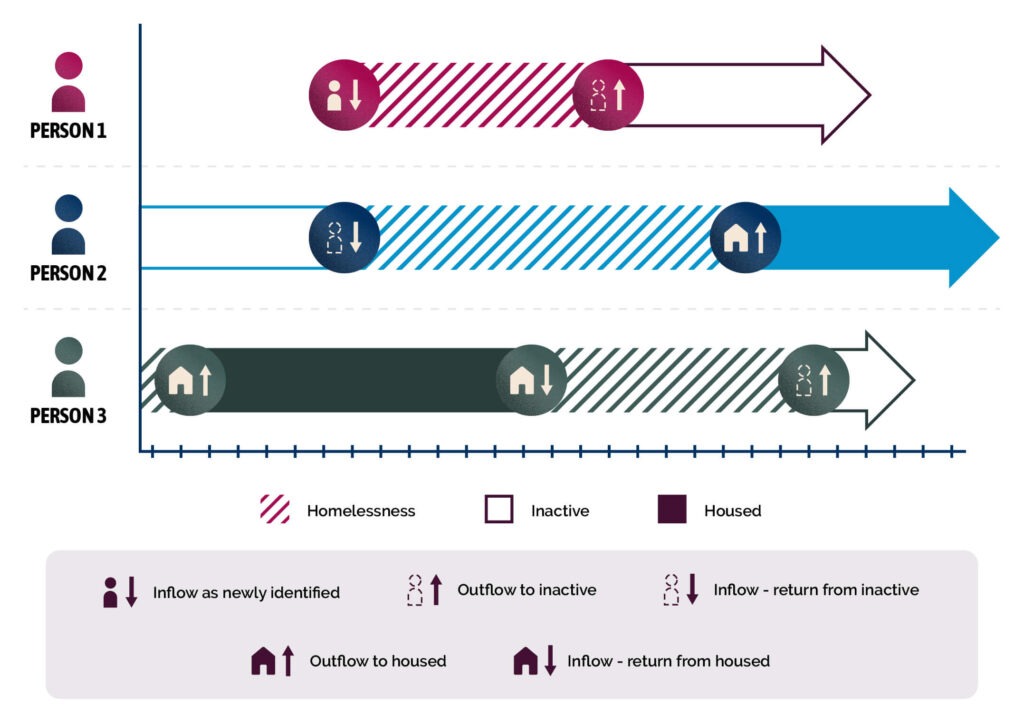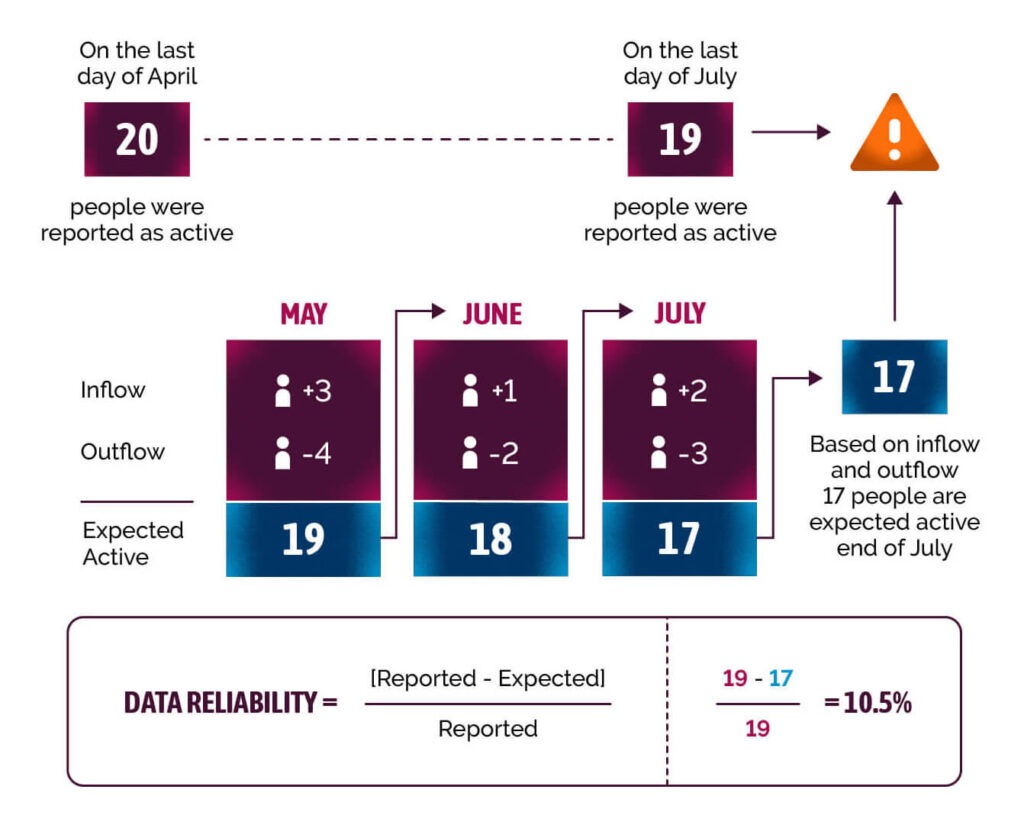Overview: Tracking List Statuses
Single Adults Scorecard: Questions 7, 9, 10, 11A, 11B, 12C
Does our community’s by-name dataset accurately reflect who is experiencing homelessness in our system and show how individuals have entered or exited our system over the past month and historically?
This overview page, in combination with the related resources and case studies, will help you answer scorecard questions 7, 9, 10, 11A, 11B, and 12C. The concepts covered will help your community understand how to track list statuses of individuals experiencing homelessness and why it matters for system improvement efforts.
What is a list status?
By-name data list statuses are part of the Built for Zero methodology to identify how someone is showing up in the homeless response system. List statuses differ from population and subpopulation status, which are described in further detail here. Identifying and tracking the list status of each individual can help your community have a complete and accurate view of who is experiencing homelessness and how they are entering and exiting the system. Key terms related to tracking list statuses are listed below and can be found in more detail in the Built for Zero Reporting Reference Guide.
- Active – Individuals who are experiencing literal homelessness in your system as of the last day of the month.
- Inflow – The statuses that identify an individual who entered your homeless response system during a specific month or who was newly identified as part of a population or subpopulation during the month. Includes newly identified, returned from housing, and returned from inactive.
- Newly Identified – The status used to identify any person who first began experiencing homelessness in your community* during the month or who met the criteria for a specific population during the month (i.e., become chronically homeless after entering homelessness as not chronic).
- Returned to Active from Housed – The status used to identify any person who first began experiencing homelessness during the month and who was previously housed within your community’s geographic region.*
- Returned to Active from Inactive – The status used to identify any person who first began experiencing homelessness during the month and who was previously experiencing homelessness within your community’s geographic region, but became inactive.*
- Outflow – The statuses that identify an individual as no longer active within your community’s geographic region, or as no longer part of a population or subpopulation during a specific month. Includes housed, inactive, or no longer meeting the population criteria of a specific population or subpopulation.
- Housed – The status used to identify any person who was experiencing homelessness and was permanently housed during the reporting month. This includes people who were housed through the homeless response system as well as people who self-resolved their housing crisis. We recommend that communities identify which of the HMIS exit destinations (Universal Data Element 3.12 – Destination) indicates a permanent housing destination locally.
- Inactive – The status used to identify any person who was experiencing homelessness but as of the last day of the month is no longer known to be experiencing homelessness in the area, per the community’s inactive policy. Read more about inactivity here.
- No Longer Meets Population Criteria – This status is used to identify when a person’s population or subpopulation status changed over the course of the month and often indicates a change to their unique characteristics or housing situation. Read more about tracking population-based status here.

*Communities often establish a “lookback period” to determine the timeframe to consider if someone is “Newly identified” or a “Return” to active homelessness, meaning that only those with a previous episode of homelessness that ended within the lookback period would be considered a return. While two years is a commonly used lookback period, to align with the 24-month HUD System Performance Measure, this is not prescriptive, and communities may adopt a timeframe that is most appropriate for their specific system, including a substantially longer period of time.
Why does tracking list statuses matter in the homeless response system?
Making sure each person is correctly identified in your by-name dataset is important for creating a trustworthy system and is a key step toward using data to improve the system. Tracking list statuses supports system coordination to get people housed quickly and to get them connected to the resources they need. Analyzing historical list statuses can shed light on the actual journey of people experiencing homelessness in your system and can highlight areas to be strengthened.
Some real world examples of why tracking list status matters are outlined below.
Methods for tracking list statuses
Tracking list statuses can seem complex, but most communities already have the necessary data to get started. The section below is primarily for the people in your community tasked with creating data-tracking systems.
The mechanics of tracking list statuses
Start with HMIS data (Homeless Management Information System), focusing on key data elements, including, but not limited to:
- Program enrollments (focusing specifically on programs that serve literally homeless individuals)
- Entry and exit dates
- Veteran and disability status
- Approximate date homelessness started
- Exit destination
This data helps identify who is experiencing homelessness and who is inflowing and outflowing. If your HMIS lacks comprehensive data, you may need to combine multiple data sources to track statuses.
Manual or automated approach?
Smaller communities may prefer to manually track list status:
- Review the list monthly and identify inflow and outflow based on changes in the active list using HMIS or other enrollment data to identify inflow and outflow categories.
Larger communities may opt for a more automated process:
- Excel Programs – Track inflow/outflow with HMIS program enrollment entry and exit data
- HMIS Reports – Leverage reports available in your HMIS system that show who is active during a specific period of time
- Custom Dashboards – Work with your HMIS team to develop a report or dashboard that tracks list status monthly
- Data Cleaning Tools – Combine datasets with Tableau Prep or similar tools and develop flows for cleaning and organizing the data
See the tools and resources section for more information on how to track list statuses
Each community will approach this process differently to develop a method specific to their system.
How does this relate to data reliability?
Data reliability is a primary component of Quality Data and is strongly related to a community’s ability to track list statuses accurately. Data Reliability measures how far off your data is from being balanced — i.e., how far off is the number of people REPORTED as actively experiencing homelessness from the number of people EXPECTED to be reported as actively experiencing homelessness based on inflow and outflow.

Related scorecard questions:
Question 7: Does your community’s by-name dataset track the “homeless/housed status” of all individuals, including the date each status was last changed and the previous status? Homeless status fields should include at minimum: homeless, inactive, and permanently housed.
Question 9: Does your by-name dataset track the total number of newly identified (not necessarily assessed) individuals experiencing homelessness every month? This figure represents a portion of your monthly inflow.
Question 10: Does your community’s by-name dataset track individuals returning to active homeless status within the past month?
Question 11a: Does your community’s by-name dataset track individuals as they move out of active homeless status, including those who move into permanent housing?
Question 11b: Does your community’s by-name dataset track individuals as they move out of active homeless status, including those who become inactive, per your inactive policy?
Question 12c: Can your by-name dataset track historical changes in activity status (e.g., active to inactive, active to housed, etc.)?
Submit Questions or Feedback
We want to hear from you! Let us know if you have specific feedback, comments, or questions about the material on this page.
Submit Questions or Feedback
We want to hear from you! Let us know if you have specific feedback, comments, or questions about the material on this page.

